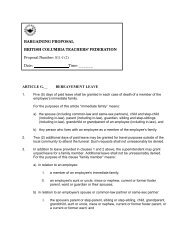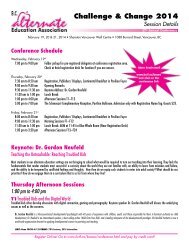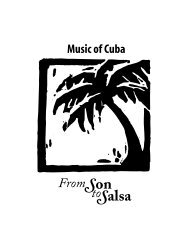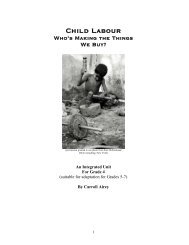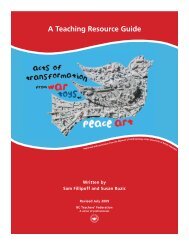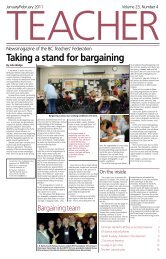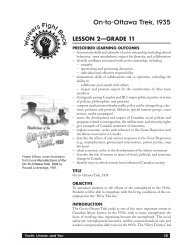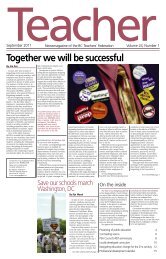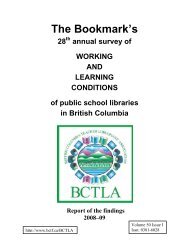You also want an ePaper? Increase the reach of your titles
YUMPU automatically turns print PDFs into web optimized ePapers that Google loves.
<strong>Music</strong> <strong>of</strong> <strong>the</strong> <strong>Andes</strong><br />
On <strong>the</strong>Wings<br />
<strong>of</strong> <strong>the</strong>Condor
<strong>Music</strong> <strong>of</strong> <strong>the</strong> <strong>Andes</strong><br />
On <strong>the</strong>Wings<br />
<strong>of</strong> <strong>the</strong>Condor<br />
Valerie Dare<br />
Joseph “Pepe” Danza<br />
Edgar Muenala<br />
Published by <strong>the</strong> B.C. Teachers’ Federation Lesson Aids Service
Copyright ©1996 Britannia World <strong>Music</strong> Program<br />
Materials may be reproduced for classroom use. All o<strong>the</strong>r uses require <strong>the</strong> permission<br />
<strong>of</strong> <strong>the</strong> authors.<br />
Britannia World <strong>Music</strong> Program<br />
Britannia Secondary School<br />
1001 Cotton Drive<br />
Vancouver, BC V5L 3T4<br />
Tel: (604) 255-9371<br />
Fax: (604) 255-8593<br />
Distributed by<br />
Lesson Aids Service – B.C. Teachers’ Federation<br />
100–550 West Sixth Avenue<br />
Vancouver, BC V5Z 4P2<br />
Tel: (604) 871-2283 • 1-800-663-9163<br />
Fax: (604) 871-2295<br />
Funding for development and publication <strong>of</strong> World <strong>Music</strong> units is provided by<br />
The Vancouver Foundation.<br />
Text design and typesetting by John McLachlan
Introduction<br />
<strong>Music</strong> <strong>of</strong> <strong>the</strong> <strong>Andes</strong>; On <strong>the</strong> Wings <strong>of</strong> <strong>the</strong> Condor<br />
Close your eyes and listen to <strong>the</strong> sound <strong>of</strong> panpipes—or is it <strong>the</strong> wind sweeping<br />
through <strong>the</strong> mountain passes <strong>of</strong> <strong>the</strong> Sierra? Andean music has <strong>the</strong> power to<br />
transport <strong>the</strong> listener to o<strong>the</strong>rworldly realms where spirits still whisper <strong>the</strong>ir<br />
sacred truths through <strong>the</strong> music <strong>of</strong> zampoñas and antaras (panpipes) and kena (quena)<br />
flutes. Most South American natives view <strong>the</strong>ir music as possessing supernatural<br />
qualities, and Western listeners must be aware <strong>of</strong> its spiritual nature in order to gain an<br />
understanding and appreciation <strong>of</strong> its functions and characteristics.<br />
Integral to <strong>the</strong> daily and ceremonial life <strong>of</strong> <strong>the</strong> Quechua and Aymara peoples,<br />
descendants <strong>of</strong> <strong>the</strong> Incas and <strong>the</strong>ir subjects, music accompanies <strong>the</strong> passage <strong>of</strong> life.<br />
Every occasion is marked by particular rhythms and dances pertaining to birth and<br />
burial, courtship and marriage, planting and harvesting, tributes to gods and supplications<br />
to <strong>the</strong> spirits <strong>of</strong> <strong>the</strong> sun, earth, and moon. Whole villages participate in festivals<br />
where poems, prayers, and stories are musically interpreted.<br />
While many Andean traditions have been absorbed by <strong>the</strong> dominant culture, some<br />
instruments date from pre-conquest times. Kenas and antaras were used along with<br />
whistles that played a single note and whistling pots which produced sound when<br />
water forced air out <strong>of</strong> a constricted head. Flute and percussion players provided music<br />
for <strong>the</strong> Inca court. Harmony was not employed. Instead, two or more players used<br />
pipes <strong>of</strong> different pitches which extended <strong>the</strong> range <strong>of</strong> notes that could be played by a<br />
single musician. Ano<strong>the</strong>r common wind instrument was <strong>the</strong> pututu, a large conch shell<br />
which played a single note that carried great distances. Used for communication, <strong>the</strong><br />
pututu was also sounded as a signal in times <strong>of</strong> war. Percussion instruments included<br />
large war drums, frame drums, rattles, and bells. Drums played at important religious<br />
ceremonies were decorated with gold and silver ornaments and sometimes were so<br />
large <strong>the</strong>y required three or four players. Smaller drums, tambourines, and bells made<br />
<strong>of</strong> copper, bronze, and silver were used in festivals. Most important ceremonies involved<br />
dance. Jingle rattles made <strong>of</strong> shells and beans were tied to <strong>the</strong> ankles <strong>of</strong> dancers<br />
to mark <strong>the</strong> rhythms, which were fast and measured. In contrast, a slow, free rhythm<br />
characterized music used for spirit communication and healing.
Stringed instruments such as <strong>the</strong> guitar, introduced by Spanish settlers, were<br />
adapted by indigenous musicians. One <strong>of</strong> <strong>the</strong> most interesting <strong>of</strong> <strong>the</strong>se adaptations is<br />
<strong>the</strong> charango, a long-necked lute with a body traditionally constructed from an armadillo<br />
shell. The violin and <strong>the</strong> harp are two o<strong>the</strong>r instruments brought to South<br />
America by <strong>the</strong> Spanish but played in a new way by <strong>the</strong> First Nations people.<br />
Despite losing many <strong>of</strong> <strong>the</strong>ir traditional ways, <strong>the</strong> Quechua and Aymara maintain<br />
<strong>the</strong>ir cultures through language, customs, and music. Six to eight million Quechuaspeaking<br />
Indians still live in villages in <strong>the</strong> highland regions <strong>of</strong> Bolivia, Ecuador, Peru,<br />
and Chile, making a living from <strong>the</strong> land and from crafts such as weaving, for which<br />
<strong>the</strong>y are world-famous. Quechuan and Aymaran musicians have no state support as<br />
Andean music is not valued by <strong>the</strong> dominant culture. Many busk on street corners in<br />
towns and cities both in <strong>the</strong>ir homeland and overseas. A few <strong>of</strong> <strong>the</strong> most talented<br />
groups tour <strong>the</strong> festival circuit. One such group is Sisa Pacari, whose name means<br />
“Flower <strong>of</strong> <strong>the</strong> New Dawn” in <strong>the</strong> Quechua language. All but one member <strong>of</strong> Sisa<br />
Pacari come from a single family in <strong>the</strong> village <strong>of</strong> La Joya, north <strong>of</strong> Otavalo in Ecuador.<br />
A successful Bolivian group based in England is Rumillajta, while Canada is home to a<br />
number <strong>of</strong> Andean musicians including <strong>the</strong> Vancouver group, America Ynka. The<br />
music <strong>of</strong> <strong>the</strong>se groups epitomizes <strong>the</strong> power <strong>of</strong> cultural expression to sustain indigenous<br />
peoples. In <strong>the</strong> words <strong>of</strong> Fausto Jimbo, cultural advisor to Sisa Pacari:<br />
“Here we are<br />
We exist.<br />
We come like <strong>the</strong> condor,<br />
floating over valleys, rivers, and mountains,<br />
expressing our songs,<br />
a message <strong>of</strong> fraternity, solidarity,<br />
in <strong>the</strong> language <strong>of</strong> <strong>the</strong> children <strong>of</strong> <strong>the</strong> sun.”<br />
Valerie Dare<br />
Edgar Muenala
Geographic Background<br />
BACKGROUND INFORMATION MAP<br />
STATISTICS<br />
RATING<br />
0 1 2 3 4 5<br />
COMPLETION ACTIVITY<br />
DEMOGRAPHIC PIE CHART<br />
<strong>Andes</strong>
Geographic Background<br />
BACKGROUND INFORMATION<br />
High in <strong>the</strong> <strong>Andes</strong> mountains, <strong>the</strong> Inca nation forged an empire<br />
that stretched 4,000 kilometers along <strong>the</strong> western edge <strong>of</strong><br />
<strong>the</strong> South American continent. Between <strong>the</strong> years 1438 and 1532,<br />
<strong>the</strong> Emperor Pachacuti and his descendants conquered <strong>the</strong> peoples<br />
<strong>of</strong> almost 100 nations whose labour was used to build a network<br />
<strong>of</strong> roads that crossed 25,000 kilometers <strong>of</strong> mountains,<br />
coastline, jungles, and deserts. Roads and o<strong>the</strong>r monumental<br />
feats <strong>of</strong> engineering which remain are evidence <strong>of</strong> a technologically<br />
advanced society.<br />
The Inca empire was subdivided into four provinces named<br />
Chinchaysuyu (northwest), Antisuyu (nor<strong>the</strong>ast), Cuntisuyu<br />
(southwest), and Collasuyu (sou<strong>the</strong>ast). The capital city and<br />
administrative centre was Cuzco. The Inca called <strong>the</strong>ir land<br />
Tahuantinsuyu, meaning “land <strong>of</strong> <strong>the</strong> four quarters.”<br />
In 1532, <strong>the</strong> Spanish conquistador, Francisco Pizarro, led<br />
fewer than 200 conquistadors on a successful campaign to end<br />
Inca rule. Through a combination <strong>of</strong> daring, luck, and circumstance,<br />
Pizarro and his men took from <strong>the</strong> Incas <strong>the</strong>ir land, <strong>the</strong>ir<br />
subjects, and more than 20 tons <strong>of</strong> gold and silver. The next<br />
three hundred years <strong>of</strong> colonial rule in South America saw <strong>the</strong><br />
indigenous population reduced from an estimated seventy to<br />
ninety million people to about three and a half to four million.<br />
Today, six to eight million Quechua and Aymara people, descendants<br />
<strong>of</strong> <strong>the</strong> Inca Empire, still live in <strong>the</strong> mountainous regions<br />
<strong>of</strong> sou<strong>the</strong>rn Colombia, Peru, Ecuador, Bolivia, and Chile.<br />
STATISTICS<br />
Size <strong>of</strong> <strong>the</strong> Inca army in 1532: 30,000<br />
Number <strong>of</strong> Pizarro and his followers: 200<br />
RATING<br />
Rate <strong>the</strong> technological achievements <strong>of</strong> <strong>the</strong> Inca.<br />
0 1 2 3 4 5<br />
low high<br />
COMPLETION ACTIVITY<br />
The emperor ________________ began <strong>the</strong> campaign to<br />
defeat 100 peoples and add <strong>the</strong>ir territory to <strong>the</strong> empire. At its<br />
height, <strong>the</strong> Inca empire stretched ___________ km from north<br />
to south. The empire was divided into ____________<br />
provinces and was called ______________.<br />
Because <strong>of</strong> <strong>the</strong>ir feats <strong>of</strong> engineering, <strong>the</strong> Incas are considered<br />
to be technologically _____________ .<br />
MAP<br />
Map Questions<br />
◆ Which emperor added <strong>the</strong> most territory to <strong>the</strong><br />
Inca empire?<br />
◆ Which emperor chose Cuzco to be <strong>the</strong> capital<br />
city?<br />
◆ Why do you think <strong>the</strong> Inca empire stretched<br />
north and south instead <strong>of</strong> east and west?<br />
DEMOGRAPHIC PIE CHART<br />
<strong>Andes</strong><br />
◆ Graph <strong>the</strong> relative numbers <strong>of</strong> First Nations<br />
soldiers and <strong>the</strong> Spanish army at <strong>the</strong> time <strong>of</strong><br />
<strong>the</strong> conquest.<br />
◆ Label <strong>the</strong> parts <strong>of</strong> <strong>the</strong> pie graph.
Socio-Political Focus<br />
<strong>Andes</strong><br />
DIRECTIONS<br />
In each box, draw and name <strong>the</strong> instruments described, and put a check mark to show whe<strong>the</strong>r <strong>the</strong> instrument is preconquest<br />
or post-conquest.<br />
MUSICAL INSTRUMENTS<br />
■ notched end flute<br />
❏ pre-conquest<br />
❏ post-conquest<br />
■ stringed instrument<br />
introduced by Europeans<br />
and popular<br />
with indigenous<br />
musicians<br />
❏ pre-conquest<br />
❏ post-conquest<br />
■ double-headed drum<br />
played with 2 sticks<br />
❏ pre-conquest<br />
❏ post-conquest<br />
■ played throughout <strong>the</strong><br />
Andean region<br />
❏ pre-conquest<br />
❏ post-conquest<br />
■ a small lute, adapted<br />
from <strong>the</strong> guitar<br />
❏ pre-conquest<br />
❏ post-conquest<br />
■ large, double-headed<br />
Quechua drum<br />
❏ pre-conquest<br />
❏ post-conquest<br />
■ ceramic, vessel<br />
■ water-filled<br />
❏ pre-conquest<br />
❏ post-conquest<br />
■ double-row pan-flutes<br />
❏ pre-conquest<br />
❏ post-conquest<br />
■ stringed instrument<br />
introduced in <strong>the</strong> late<br />
1500s by Irish Jesuits<br />
❏ pre-conquest<br />
❏ post-conquest<br />
■ large conch shell<br />
❏ pre-conquest<br />
❏ post-conquest
Socio-Political Focus<br />
DIRECTIONS<br />
Have students use <strong>the</strong> information below to complete <strong>the</strong> facing page.<br />
Pre-conquest<br />
(indegenous)<br />
■ Most commonly played<br />
flute<br />
■ notched end, 6 sound<br />
holes in front, 1 on <strong>the</strong><br />
back<br />
■ produces warm, s<strong>of</strong>t notes<br />
as well as clear, sharp ones<br />
■ double-row pan-flutes<br />
■ varies in size<br />
■ players can alternate<br />
■ most characteristic sound<br />
in Andean music<br />
■ large conch shell<br />
■ trading item<br />
■ sound carries over long<br />
distances<br />
■ ceramic vessel<br />
■ water-filled<br />
■ air is forced through a<br />
narrow opening<br />
■ large, double-headed<br />
drum<br />
■ animal skins are roped<br />
toge<strong>the</strong>r<br />
■ deep sound<br />
■ Quechua word for drum<br />
Kena<br />
Sikus<br />
MUSICAL INSTRUMENTS<br />
Charango<br />
Guitar<br />
Pututu Violin<br />
Whistling pot Harp<br />
Wankara Bombo<br />
<strong>Andes</strong><br />
Post-conquest<br />
(introduced by <strong>the</strong> Spaniards)<br />
■ local adaptation <strong>of</strong> <strong>the</strong><br />
guitar<br />
■ 5 double strings<br />
■ sound box sometimes<br />
made from armadillo<br />
shell<br />
■ various sizes<br />
■ played throughout <strong>the</strong><br />
Andean region<br />
■ introduced by Europeans<br />
■ popular with indigenous<br />
musicians<br />
■ introduced in <strong>the</strong> late<br />
1500s by Irish Jesuits<br />
■ enlarged sound box<br />
■ 32 stings<br />
■ double-headed drum<br />
■ played with 2 sticks<br />
■ possibly originated in<br />
Turkey
Viewing Guide<br />
DIRECTIONS<br />
Watch <strong>the</strong> first seven minutes <strong>of</strong> <strong>the</strong> video Incas; Secrets <strong>of</strong> <strong>the</strong> Ancestors, and answer <strong>the</strong> questions below.<br />
1. In what year was Inca civilization at its height?<br />
3. What is <strong>the</strong> name <strong>of</strong> <strong>the</strong> leader and whom did he<br />
defeat?<br />
5. Were <strong>the</strong> Incas <strong>the</strong> first civilization in <strong>the</strong> region?<br />
❏ yes<br />
❏ no<br />
7. Which god was considered to be <strong>the</strong> Inca’s spiritual<br />
fa<strong>the</strong>r?<br />
9. EVALUATION How do you know that <strong>the</strong> Inca<br />
considered communication througout <strong>the</strong> empire to<br />
be important?<br />
2. What kind <strong>of</strong> war has just ended?<br />
<strong>Andes</strong><br />
4. Name three things that made <strong>the</strong> land <strong>of</strong> <strong>the</strong> Incas a<br />
difficult place to live?<br />
6. What well-known past civilization is compared to<br />
<strong>the</strong> Inca Empire?<br />
Which civilization is earlier?<br />
8. What is one <strong>of</strong> <strong>the</strong> Inca’s creations that has<br />
endured?<br />
10. CHOICE What did you see or hear that most<br />
impressed you about <strong>the</strong> Inca civilization?<br />
11. MAKE YOUR OWN QUESTION 12. MAKE YOUR OWN QUESTION
Viewing Guide<br />
DIRECTIONS<br />
Have students watch <strong>the</strong> first seven minutes <strong>of</strong> <strong>the</strong> video Incas; Secrets <strong>of</strong> <strong>the</strong> Ancestors, and answer <strong>the</strong> questions below.<br />
1. In what year was Inca civilization at its height?<br />
a.d. 1532.<br />
3. What is <strong>the</strong> name <strong>of</strong> <strong>the</strong> leader and whom did he<br />
defeat?<br />
Atahuallpa defeated his bro<strong>the</strong>r.<br />
5. Were <strong>the</strong> Incas <strong>the</strong> first civilization in <strong>the</strong> region?<br />
❏ yes<br />
❏ ✓no<br />
7. Which god was considered to be <strong>the</strong> Inca’s spiritual<br />
fa<strong>the</strong>r?<br />
Inti, <strong>the</strong> Sun God<br />
9. EVALUATION How do you know that <strong>the</strong> Inca<br />
considered communication throughout <strong>the</strong> empire<br />
to be important?<br />
2. What kind <strong>of</strong> war has just ended?<br />
a civil war<br />
4. Name three things that made <strong>the</strong> land <strong>of</strong> <strong>the</strong> Incas a<br />
difficult place to live?<br />
a. volcanoes<br />
b. earthquakes<br />
c. thin air<br />
6. What well-known past civilization is compared to<br />
<strong>the</strong> Inca Empire?<br />
Roman Empire<br />
Which civilization is <strong>the</strong> earlier?<br />
Roman<br />
8. What is one <strong>of</strong> <strong>the</strong> Inca’s creations that has<br />
endured?<br />
eg. a city in <strong>the</strong> mountains (Machu Picchu)<br />
10. CHOICE What did you see or hear that most<br />
impressed you about <strong>the</strong> Inca civilization?<br />
11. MAKE YOUR OWN QUESTION 12. MAKE YOUR OWN QUESTION<br />
<strong>Andes</strong>
Listening Guide<br />
DIRECTIONS<br />
Listen to <strong>the</strong> song, Cayambeño, by Sisa Pacari, from <strong>the</strong> CD recording, Wardance Against <strong>the</strong> Invadors, and circle <strong>the</strong><br />
appropriate word or words.<br />
STYLE<br />
a capella or accompanied fast tempo or slow tempo<br />
solo or chorus simple or complex<br />
call and response always changing or repetitive<br />
melismatic or one note per syllable<br />
INSTRUMENTS<br />
gong electric guitar keyboard xylophone<br />
drum kit chirango marimba bodhran<br />
saxophone bombo bass guitar piano<br />
bongo drums rattle acoustic guitar flute kena<br />
MY FEELINGS<br />
curious or content<br />
excited or peaceful<br />
angry or romantic<br />
happy or sad<br />
calm or energetic<br />
powerful or weak<br />
confident or confused<br />
homesick or content<br />
THE PICTURE I SEE<br />
<strong>Andes</strong>
Listening Guide<br />
DIRECTIONS<br />
Have students listen to Cayambeño, by Sisa Pacari, from <strong>the</strong> CD recording, Wardance Against <strong>the</strong> Invadors, and circle <strong>the</strong><br />
appropriate word or words. This song was sung and danced at Inti Raimi, <strong>the</strong> festival held to honour <strong>the</strong> Sun God, Inti,<br />
on <strong>the</strong> day <strong>of</strong> <strong>the</strong> winter solstice.<br />
STYLE<br />
a capella or accompanied fast tempo or slow tempo<br />
solo or chorus simple or complex<br />
call and response always changing or repetitive<br />
melismatic or one note per syllable<br />
INSTRUMENTS<br />
gong electric guitar keyboard xylophone<br />
drum kit chirango marimba bodhran<br />
saxophone bombo bass guitar piano<br />
bongo drums rattle acoustic guitar flute kena<br />
MY FEELINGS<br />
curious or content<br />
excited or peaceful<br />
angry or romantic<br />
happy or sad<br />
calm or energetic<br />
powerful or weak<br />
confident or confused<br />
homesick or content<br />
THE PICTURE I SEE<br />
<strong>Andes</strong>
Song Writing<br />
DEFINITION MODEL SONG LYRICS<br />
WHAT IS A ?<br />
DEFINITION:<br />
DIRECTIONS THE NEW SONG<br />
Step 1: Watch <strong>the</strong> teacher<br />
make <strong>the</strong> first line.<br />
Step 2: Help <strong>the</strong> teacher<br />
make <strong>the</strong> second line.<br />
Step 3: Make a third line<br />
with <strong>the</strong> teacher’s help.<br />
Step 4: Write a fourth line<br />
yourself.<br />
TITLE:<br />
<strong>Andes</strong>
Song Writing<br />
DEFINITION MODEL SONG LYRICS<br />
WHAT IS A love song ?<br />
DEFINITION:<br />
Expresses deep emotions toward <strong>the</strong> subject <strong>of</strong> <strong>the</strong> song;<br />
can be joyful, but is <strong>of</strong>ten melancholy.<br />
■ can be addressed to a loved one.<br />
■ may show depth <strong>of</strong> feeling for one’s country or<br />
people.<br />
■ <strong>of</strong>ten uses metaphor (indirectly comparing one<br />
thing to ano<strong>the</strong>r).<br />
DIRECTIONS THE NEW SONG<br />
Step 1: Watch <strong>the</strong> teacher<br />
make <strong>the</strong> first line.<br />
Step 2: Help <strong>the</strong> teacher<br />
make <strong>the</strong> second line.<br />
Step 3: Make a third line<br />
with <strong>the</strong> teacher’s help.<br />
Step 4: Write a fourth line<br />
yourself.<br />
TITLE:<br />
Sariri*<br />
Quechua<br />
Part 1<br />
Llactaman chayana cani<br />
ñucata Mama shuyajum<br />
Quechuacunapac Alpapalla<br />
Facha laya llactagu<br />
Part 2<br />
Ura Manta purijcunac cani<br />
Mama quillacsha purinchic<br />
ñuca mashi Wayrawuan<br />
ñuca yuyaipi pillushca<br />
Runa samay shunguan<br />
ruana ucupi Wayrawuan<br />
English<br />
* song Sariri, courtesy <strong>of</strong> Edgar Muenala<br />
<strong>Andes</strong><br />
Part 1<br />
I have to go to my village<br />
where my mo<strong>the</strong>r is waiting for me<br />
in <strong>the</strong> land <strong>of</strong> dark-skinned people<br />
and <strong>the</strong> beautiful landscape.<br />
Part 2<br />
I am Sariri from <strong>the</strong> <strong>Andes</strong>.<br />
I have walked for many moons<br />
with <strong>the</strong> Wayra spirit as a friend,<br />
surrounded by my memories,<br />
with <strong>the</strong> warmth <strong>of</strong> my race<br />
within my flowing poncho.
Dance<br />
<strong>Andes</strong><br />
DIRECTIONS<br />
Listen to examples <strong>of</strong> wayno songs. Find pictures <strong>of</strong> traditional costumes and colour <strong>the</strong> clothing shown below.<br />
DESCRIPTION<br />
The wayno (or huayno) is <strong>the</strong> national dance <strong>of</strong> Peru. The<br />
name refers both to a dance style and a musical genre<br />
which dates from pre-Colombian times. Characteristics<br />
include a moderate tempo and an ending section called a<br />
fuga in which <strong>the</strong> <strong>the</strong>me <strong>of</strong> <strong>the</strong> song is repeated at twice <strong>the</strong><br />
original tempo.<br />
The wayno dance is a scarf dance performed by couples.<br />
It may be accompanied by groups <strong>of</strong> panpipes and a drum,<br />
by various stringed instruments, or even by a brass band.<br />
The <strong>the</strong>me <strong>of</strong> most waynos is romantic love.<br />
ILLUSTRATION OR STEPS DIAGRAM<br />
COSTUME AND/OR INSTRUMENTS<br />
from <strong>Music</strong> <strong>of</strong> <strong>the</strong> <strong>Andes</strong>; an Introduction to <strong>the</strong> Instruments Pre and Post Conquest.
Dance<br />
DIRECTIONS<br />
Have students listen to examples <strong>of</strong> wayno songs by Sukay. Have students find pictures <strong>of</strong> traditional costumes and colour<br />
<strong>the</strong> clothing shown below.<br />
DESCRIPTION<br />
The wayno (or huayno) is <strong>the</strong> national dance <strong>of</strong> Peru. The<br />
name refers both to a dance style and a musical genre<br />
which dates from pre-Colombian times. Characteristics<br />
include a moderate tempo and an ending section called a<br />
fuga in which <strong>the</strong> <strong>the</strong>me <strong>of</strong> <strong>the</strong> song is repeated at twice <strong>the</strong><br />
original tempo.<br />
The wayno dance is a scarf dance performed by couples.<br />
It may be accompanied by groups <strong>of</strong> panpipes and a drum,<br />
by various stringed instruments, or even by a brass band.<br />
The <strong>the</strong>me <strong>of</strong> most waynos is romantic love.<br />
ILLUSTRATION OR STEPS DIAGRAM<br />
COSTUME AND/OR INSTRUMENTS<br />
<strong>Andes</strong><br />
from <strong>Music</strong> <strong>of</strong> <strong>the</strong> <strong>Andes</strong>; an Introduction to <strong>the</strong> Instruments Pre and Post Conquest.
<strong>Music</strong>al Instruments<br />
DIRECTIONS<br />
Use <strong>the</strong> cd-rom program, <strong>Music</strong>al Instruments, to research <strong>the</strong> ___________________ .<br />
NAME & CLASSIFICATION<br />
membranophone idiophone chordophone aerophone<br />
ORIGINS & GEOGRAPHICAL DISTRIBUTION<br />
MATERIALS FAMILY<br />
wood<br />
metal<br />
skin<br />
bone<br />
plastic<br />
SIZE<br />
RELATED INSTRUMENTS<br />
PITCH RANGE<br />
PERFORMANCE DETAILS<br />
LOOKS LIKE<br />
<strong>Andes</strong>
<strong>Music</strong>al Instruments<br />
DIRECTIONS<br />
Have students use <strong>the</strong> cd-rom program, <strong>Music</strong>al Instruments, to research <strong>the</strong> charango, or o<strong>the</strong>r indigenous instrument.<br />
NAME & CLASSIFICATION<br />
Charango membranophone idiophone chordophone aerophone<br />
ORIGINS & GEOGRAPHICAL DISTRIBUTION<br />
■ adapted from <strong>the</strong> bandurria, a guitarlike<br />
instrument introduced by Spanish<br />
settlers<br />
■ made originally from an armadillo shell<br />
■ <strong>the</strong> name comes from <strong>the</strong> Quechua<br />
word, kirkinchu, meaning “armadillo”<br />
■ played in <strong>the</strong> Andean region <strong>of</strong> South<br />
America<br />
MATERIALS FAMILY<br />
wood ✔<br />
metal ✔<br />
skin<br />
bone<br />
plastic<br />
armadillo shell ✔<br />
Strings<br />
RELATED INSTRUMENTS<br />
Lute<br />
Bouzouki<br />
Oud<br />
Balalaika<br />
Chitaronne<br />
Ukelele<br />
Banjo<br />
Pipa<br />
Shamisen<br />
Mandolin<br />
Sitar<br />
Yuegin<br />
SIZE<br />
43 – 64 cm<br />
PITCH RANGE<br />
1 3 /4 octaves<br />
PERFORMANCE DETAILS<br />
Played mainly by men, <strong>the</strong> charango has five sets <strong>of</strong> double strings<br />
strummed to provide accompaniment to folk music performed during<br />
courtship or festival dances. The charango is commonly used in contemporary<br />
latin music ensembles as a rhythm instrument.<br />
LOOKS LIKE<br />
<strong>Andes</strong><br />
from <strong>Music</strong> <strong>of</strong> <strong>the</strong> <strong>Andes</strong>; an Introduction to <strong>the</strong> Instruments Pre and Post Conquest.
<strong>Music</strong>ians<br />
DIRECTIONS<br />
Design an album cover which expresses <strong>the</strong> spirit <strong>of</strong> <strong>the</strong> music played by <strong>the</strong> Andean group you enjoy <strong>the</strong> most.<br />
Complete <strong>the</strong> information about <strong>the</strong> music <strong>of</strong> each group or artist.<br />
ALBUM COVER<br />
GROUP<br />
Name: Sisa Pacari<br />
Rhythm Style:<br />
Instruments Played:<br />
A Song Title:<br />
Genre/Purpose for Song:<br />
GROUP<br />
Name: America Ynka<br />
Rhythm Style:<br />
Instruments Played:<br />
A Song Title:<br />
Genre/Purpose for Song:<br />
GROUP<br />
Name: Sukay<br />
Rhythm Style:<br />
Instruments Played:<br />
A Song Title:<br />
Genre/Purpose for Song:<br />
GROUP<br />
Name: Rumillajta<br />
Rhythm Style:<br />
Instruments Played:<br />
A Song Title:<br />
Genre/Purpose for Song:<br />
<strong>Andes</strong>
<strong>Music</strong>ians<br />
DIRECTIONS<br />
Have students listen to each <strong>of</strong> <strong>the</strong> following groups, choose one, and design an album cover which expresses <strong>the</strong> spirit<br />
<strong>of</strong> <strong>the</strong>ir music.<br />
ALBUM COVER<br />
GROUP<br />
Name: Sisa Pacari<br />
Rhythm Style: Lamento<br />
Instruments Played: bombo<br />
sikus<br />
rattle<br />
kena<br />
charango<br />
guitar & bass guitar<br />
A Song Title: El Condor Pasa*<br />
Genre/Purpose for Song: political<br />
* from Wardance Against <strong>the</strong> Invaders<br />
GROUP<br />
Name: America Ynka<br />
Rhythm Style: Inti Raimi (San Juanito)<br />
Instruments Played: kenas<br />
rattle (chacchas)<br />
guitar<br />
bandolin<br />
violin<br />
A Song Title: Sabado Chishi*<br />
Genre/Purpose for Song: dance<br />
* from Ynka Nan<br />
GROUP<br />
Name: Sukay<br />
Rhythm Style: Wayno<br />
Instruments Played: sikus<br />
charango<br />
guitar<br />
drum<br />
rattle<br />
A Song Title: Khuyaylla*<br />
Genre/Purpose for Song: dance<br />
* from Huayrasan<br />
GROUP<br />
Name: Rumillajta<br />
Rhythm Style: unknown<br />
Instruments Played: zampoña<br />
kena<br />
antara<br />
charango<br />
guitar<br />
bombo<br />
A Song Title: Tempestad*<br />
Genre/Purpose for Song: unknown<br />
* from Wiracocha<br />
<strong>Andes</strong>
Religion<br />
<strong>Andes</strong><br />
DIRECTIONS<br />
Use <strong>the</strong> text on <strong>the</strong> opposite page to make notes in point form on each <strong>of</strong> <strong>the</strong> topics listed. Notes on Religion are done<br />
for you as an example.<br />
Note: <strong>the</strong>re is no example given for a prayer song, as <strong>the</strong>se were secret.<br />
RELIGION<br />
Sun<br />
■ ancestor <strong>of</strong> <strong>the</strong> Incas<br />
■ associated with prestige, power<br />
■ studied by astronomers<br />
• movements recorded in 12-month calendar<br />
■ “giver <strong>of</strong> life”<br />
• matured crops such as maize (corn)<br />
• most important crop<br />
• associated with <strong>the</strong> sun<br />
• grown in <strong>the</strong> intipampa<br />
(field <strong>of</strong> <strong>the</strong> sun)<br />
EXAMPLE<br />
Prayer Song<br />
FOCUS<br />
Inti Raimi<br />
■ Time <strong>of</strong> Year<br />
■ Sacrifices<br />
■ Celebrations<br />
WORSHIP<br />
Prayers Paying reverence<br />
■ Informal ■ landmarks<br />
■ Formal ■ festivals and ceremonies
Religion<br />
<strong>Andes</strong><br />
DIRECTIONS<br />
Have students use <strong>the</strong> text below to make notes in point form on <strong>the</strong> student activity sheet on <strong>the</strong> facing page.<br />
RELIGION<br />
The sun was considered to be <strong>the</strong> divine ancestor <strong>of</strong> <strong>the</strong><br />
Inca dynasty and was associated with prestige and power.<br />
Inca astronomers studied <strong>the</strong> sun’s movements and recorded<br />
<strong>the</strong>m in a twelve month calendar closely linked<br />
with agricultural practices. The sun in <strong>the</strong> cold highlands<br />
was <strong>the</strong> “giver <strong>of</strong> life” whose presence transformed <strong>the</strong><br />
environment and brought about <strong>the</strong> maturing <strong>of</strong> vital<br />
crops, such as maize (corn). Maize was <strong>the</strong> colour <strong>of</strong> <strong>the</strong><br />
sun’s rays and became associated with divinity. As a crop<br />
it was given priority in <strong>the</strong> intipampa (field <strong>of</strong> <strong>the</strong> sun) beside<br />
<strong>the</strong> main temple <strong>of</strong> <strong>the</strong> Inca religion, <strong>the</strong> Kojcamcha<br />
in Cuzco.<br />
EXAMPLE<br />
The words for songs performed at Inti Raimi were secret<br />
and <strong>the</strong>refore cannot be reproduced here.<br />
FOCUS<br />
Inti Raimi<br />
The “Feast <strong>of</strong> <strong>the</strong> Sun” was held in <strong>the</strong> hills near <strong>the</strong> capital<br />
city <strong>of</strong> Cuzco at <strong>the</strong> winter solstice in June. Sacrifices,<br />
including children, gold and silver vessels, and white llamas<br />
were <strong>of</strong>fered to <strong>the</strong> Sun God, Inti Raimi. After <strong>the</strong><br />
sacrifices, <strong>the</strong> celebrations continued with feasting and<br />
dancing. Dancers in elaborate costumes tied rattles around<br />
<strong>the</strong>ir ankles, assumed traditional dance formations, and<br />
danced to <strong>the</strong> sounds <strong>of</strong> flutes, bells, panpipes, and drums.<br />
WORSHIP<br />
Prayers and communications with <strong>the</strong> gods could be made silently, aloud, or with gestures. Prayers could be made up<br />
informally to suit <strong>the</strong> occasion, or priests and friends could be asked to say more formal prayers. Traditional prayers were<br />
recited at important ceremonial occasions. Reverence was also paid to landmarks such as water sources, fields <strong>of</strong> <strong>the</strong> sun,<br />
and mountains in simple ways such as adding a stone to <strong>the</strong> apacita (pile <strong>of</strong> stones). Preparation for most festivals and<br />
ceremonies almost always included cleansing and fasting by <strong>the</strong> participants.
Folk Tale page 1<br />
DIRECTIONS<br />
Read Necklace <strong>of</strong> Stars and complete <strong>the</strong> activity sheets.<br />
TITLE<br />
CHARACTERS VOCABULARY<br />
The main characters are:<br />
The hero <strong>of</strong> <strong>the</strong> story is:<br />
The villain <strong>of</strong> <strong>the</strong> story is:<br />
New words I learned are:<br />
The story includes a musical instrument called <strong>the</strong><br />
means<br />
means<br />
means<br />
means<br />
means<br />
means<br />
means<br />
INSTRUMENT LOOKS LIKE WORDS THAT DESCRIBE THE INSTRUMENT ARE:<br />
Looks like: Sounds like:<br />
<strong>Andes</strong>
Folk Tale page 1<br />
DIRECTIONS<br />
Have students read <strong>the</strong> story Necklace <strong>of</strong> Stars, and complete <strong>the</strong> activity sheets.<br />
TITLE<br />
Necklace <strong>of</strong> Stars<br />
CHARACTERS VOCABULARY<br />
The main characters are:<br />
Miguel<br />
Miguel’s parents<br />
The hero <strong>of</strong> <strong>the</strong> story is:<br />
Miguel<br />
The villain <strong>of</strong> <strong>the</strong> story is:<br />
New words I learned are:<br />
The story includes a musical instrument called <strong>the</strong> panpipes<br />
poncho means a kind <strong>of</strong> coat without sleeves<br />
eucalyptus means a tall evergreen tree with<br />
aromatic leaves<br />
Coya means a personal name; Inca queen<br />
majestic means stately and dignified<br />
emerald means a green colour;<br />
a precious stone<br />
ancient means old; traditional<br />
echoed means repeated<br />
INSTRUMENT LOOKS LIKE WORDS THAT DESCRIBE THE INSTRUMENT ARE:<br />
Looks like: Sounds like:<br />
tubes wind<br />
raft breath<br />
stone flute<br />
carved echo<br />
<strong>Andes</strong>
Folk Tale page 2<br />
SETTING<br />
The physical setting for <strong>the</strong> story looks like:<br />
THEME<br />
The central idea <strong>of</strong> <strong>the</strong> story is:<br />
PLOT<br />
Introduction<br />
Rising Action<br />
Climax<br />
<strong>Andes</strong><br />
Conclusion
Folk Tale page 2<br />
SETTING<br />
The physical setting for <strong>the</strong> story looks like:<br />
THEME<br />
The central idea <strong>of</strong> <strong>the</strong> story is:<br />
All <strong>the</strong> riches <strong>of</strong> <strong>the</strong> world can’t compare to <strong>the</strong> warmth and security <strong>of</strong> home and family.<br />
PLOT<br />
Introduction<br />
• Miguel lives high<br />
in <strong>the</strong> mountains<br />
in a hut with his<br />
parents.<br />
• Everyone else has<br />
gone to <strong>the</strong> cities<br />
in search <strong>of</strong> a<br />
better life.<br />
Rising Action<br />
• Miguel plays by himself.<br />
• He listens to his fa<strong>the</strong>r’s stories and<br />
goes to find an emerald lake.<br />
• He finds <strong>the</strong> lake and tries to capture<br />
seven ducks so he will be wealthly.<br />
• He captures <strong>the</strong> ducks with a<br />
necklace made from stars.<br />
Climax<br />
• Miguel<br />
must<br />
choose<br />
between<br />
wealth and<br />
his parents.<br />
• Miguel chooses to stay<br />
with his parents.<br />
• He is no longer curious<br />
about <strong>the</strong> outside<br />
world.<br />
• The necklace <strong>of</strong> stars is<br />
changed to emeralds<br />
and seven ducks.<br />
<strong>Andes</strong><br />
Conclusion
Glossary <strong>of</strong> Terms<br />
DIRECTIONS<br />
Write <strong>the</strong> meaning <strong>of</strong> each <strong>of</strong> <strong>the</strong> following words. Draw a picture or write a sentence which shows <strong>the</strong> meaning <strong>of</strong><br />
<strong>the</strong> word.<br />
WORD<br />
Antara<br />
MEANING SENTENCE OR ILLUSTRATION<br />
Aymara<br />
Charango<br />
Cuzco<br />
Inti<br />
Kena<br />
Pututu<br />
Quechua<br />
Sikus<br />
Tahuantinsuyu<br />
Wayno<br />
(Huano)<br />
<strong>Andes</strong>
Glossary <strong>of</strong> Terms<br />
DIRECTIONS<br />
Have students complete ei<strong>the</strong>r word, meaning, sentence, or illustration for <strong>the</strong> following terms.<br />
WORD MEANING SENTENCE OR ILLUSTRATION<br />
Antara<br />
Aymara<br />
Charango<br />
Cuzco<br />
Inti<br />
Kena<br />
Pututu<br />
Quechua<br />
Sikus<br />
Tahuantinsuyu<br />
Wayno<br />
(Huano)<br />
single-row pan-flute from<br />
Peru<br />
First Nations people from<br />
Bolivia<br />
small guitar-like instrument<br />
traditionally made<br />
from an armadillo shell<br />
capital city <strong>of</strong> <strong>the</strong> Incas<br />
<strong>the</strong> Sun God<br />
end-blown flute<br />
conch shell used as a<br />
trumpet<br />
descendants <strong>of</strong> <strong>the</strong> Incas<br />
double-row pan-flutes<br />
“Land <strong>of</strong> Four Directions;”<br />
name <strong>of</strong> <strong>the</strong> Inca homeland<br />
a 2 /4 dance rhythm; a<br />
musical genre<br />
<strong>Andes</strong>
Instrument Building<br />
MATERIALS<br />
■ 5 feet <strong>of</strong> stiff plastic tubing with a diameter <strong>of</strong> 5 /8".<br />
■ plugs for <strong>the</strong> tubes (plasticine will work).<br />
■ yarn to lace pipes toge<strong>the</strong>r.<br />
■ sharp knife<br />
■ ruler<br />
■ 4 flat sticks about 6" long<br />
DIRECTIONS<br />
1. Cut <strong>the</strong> tubing to eight lengths which correspond to <strong>the</strong> solfa scale:<br />
do 8 3 /8" sol 5 3 /8"<br />
re 7 1 /2" la 4 3 /4"<br />
me 6 1 /2" ti 4 1 /4"<br />
fa 6" do 4"<br />
2. Plug <strong>the</strong> bottom <strong>of</strong> <strong>the</strong> tubes.<br />
3. Place <strong>the</strong> flat sticks against <strong>the</strong> tubes and wind yarn around <strong>the</strong>m to hold <strong>the</strong>m secure (see illustration). The pipes<br />
may also be glued toge<strong>the</strong>r for added stability.<br />
4. Hold <strong>the</strong> panpipes vertically and blow across <strong>the</strong>m at a 45º angle. Take a deep breath as <strong>of</strong>ten as necessary.<br />
ILLUSTRATION<br />
Panpipes
Performance/Workshop<br />
RESOURCE PEOPLE<br />
Name: Edgar Meunala, Aristic Director <strong>of</strong> America Ynka<br />
Contact Information: 4010 Dominion Street<br />
Burnaby, bc v5g 1c3<br />
Tel (604) 872-7466 / Fax (604) 872-7466<br />
Audience Participants: Suitable for students in grades 6-10 (curriculum tie with grade 6 social studies)<br />
PERFORMANCE/WORKSHOP DESCRIPTION<br />
Culture <strong>of</strong> <strong>the</strong> Quechua People.<br />
Focus: Edgar will provide a historical, geographical, and sociological overview <strong>of</strong> <strong>the</strong> Inca Empire, including<br />
language and music. He will show examples <strong>of</strong> crafts and demonstrate traditional instruments.<br />
STAGING REQUIREMENTS<br />
Best done in a classroom, <strong>the</strong> workshop<br />
requires no special equipment. Needed are an<br />
electrical outlet, somewhere to hang <strong>the</strong> map,<br />
and a display table for crafts and instruments.<br />
LEARNING RESOURCES<br />
Map <strong>of</strong> South America<br />
recording, Ynka Nan, by America Ynka<br />
equipment needed: CD Player<br />
PRE-PERFORMANCE SUGGESTIONS<br />
Introduce <strong>the</strong> history <strong>of</strong> <strong>the</strong> Inca Empire from 1200 ad to 1532 ad.<br />
Stage Diagram<br />
<strong>Andes</strong><br />
POST-PERFORMANCE SUGGESTIONS<br />
Examine <strong>the</strong> socio/political history <strong>of</strong> <strong>the</strong> Quechua and Aymara and <strong>the</strong>ir ties with North American First Nations peoples.
THE KNOWLEDGE FRAMEWORK (adapted from B. Mohan, 1986)<br />
CLASSIFICATION/CONCEPTS<br />
PRINCIPLES<br />
The Knowledge Framework <strong>Andes</strong><br />
EVALUATION<br />
Thinking Process: appreciating,<br />
empathizing<br />
Thinking Process: indentification <strong>of</strong> sounds<br />
<strong>of</strong> instruments<br />
Thinking Process: reviewing,<br />
relating concepts<br />
Language: names <strong>of</strong> feelings,<br />
instruments, styles<br />
Language: names <strong>of</strong> instruments,<br />
description <strong>of</strong> inst.,<br />
classification <strong>of</strong> inst.<br />
Focus: pre- and post- conquest<br />
music<br />
Language: proper and generic<br />
nouns<br />
Focus: listening activity,<br />
album cover<br />
Focus: Inca Empire, religion<br />
Key Visual: graphic organizers:<br />
Listening Guide<br />
<strong>Music</strong>ians<br />
Key Visual: graphic organizer:<br />
Socio-Political Focus<br />
Key Visual: graphic organizer:<br />
Geographic<br />
Background<br />
K<br />
N<br />
O<br />
W<br />
L<br />
E<br />
D<br />
G<br />
E<br />
B<br />
A<br />
C<br />
K<br />
G<br />
R<br />
O<br />
U<br />
N<br />
D<br />
Thinking Process: making decisions<br />
proposing alterations<br />
Thinking Process: sequencing,<br />
following instructions<br />
Thinking Process: interpreting,<br />
researching,<br />
reaching conclusions<br />
Language: could, would, should<br />
Language: first, second, third,<br />
<strong>the</strong>n, after<br />
Language: names <strong>of</strong> musicians,<br />
instruments, styles<br />
A<br />
C<br />
T<br />
I<br />
O<br />
N<br />
Focus: choosing an<br />
artist/group to<br />
research<br />
Focus: viewing,<br />
instrument building<br />
Focus: representative<br />
musicians<br />
Key Visual: graphic organizer:<br />
Andean <strong>Music</strong>ians<br />
Key Visual: graphic organizers:<br />
Guided Viewing<br />
Dance<br />
Instrument-building<br />
Key Visual: graphic organizer:<br />
Andean <strong>Music</strong>ians<br />
S<br />
I<br />
T<br />
U<br />
S<br />
T<br />
I<br />
O<br />
N<br />
CHOICE<br />
SEQUENCE<br />
DESCRIPTION
Reference Sources<br />
BOOKS<br />
Alltree, Judith. Sisa Pacari, Flower <strong>of</strong> <strong>the</strong> New Dawn; an Educational Guide and Introduction to <strong>the</strong> Country, <strong>the</strong> People and<br />
<strong>Music</strong> <strong>of</strong> Ecuador. Toronto: Novater Artists ©1996.<br />
Blackwood, Alan. <strong>Music</strong> <strong>of</strong> <strong>the</strong> World. London: Quarto Publishing, ©1991.<br />
Charles, Veronika Martenova. Necklace <strong>of</strong> Stars.* Toronto: Stodart, ©1996.<br />
Kendall, Ann. Everyday Life <strong>of</strong> <strong>the</strong> Incas. New York: GP Putnam’s Sons, ©1973.<br />
<strong>Music</strong> <strong>of</strong> <strong>the</strong> <strong>Andes</strong>; an Introduction to <strong>the</strong> Instruments Pre and Post Conquest. Vancouver: Frances York, ©1988.<br />
<strong>Music</strong>al Instruments <strong>of</strong> <strong>the</strong> World. New York: Facts on File, ©1976.<br />
Olsen, Dale A. “Symbol and Function in South American Indian <strong>Music</strong>,” from <strong>Music</strong>s <strong>of</strong> <strong>the</strong> Many Cultures—an<br />
Introduction. Berkeley: University <strong>of</strong> California Press, ©1980. pp. 363-385.<br />
Olsen, Dale A. “Folk <strong>Music</strong> <strong>of</strong> South America—a <strong>Music</strong>al Mosaic,” from <strong>Music</strong>s <strong>of</strong> <strong>the</strong> Many Cultures—an<br />
Introduction. Berkeley: University <strong>of</strong> California Press, ©1980. pp. 386–425.<br />
Waring, Dennis. Making Wood Folk Instruments. New York: Sterling Publishing Co., Inc., ©1979.<br />
Wolfe, Charles B., Jan Fairley and Margaret Bullen. “Andean <strong>Music</strong>: Beyond <strong>the</strong> Panpipes and Ponchos,” from World<br />
<strong>Music</strong>; <strong>the</strong> Rough Guide. Toronto: Penguin Books, ©1994. pp. 584-592.<br />
SOUND RECORDINGS<br />
America Ynka. Ynka Nan; <strong>the</strong> Sound <strong>of</strong> <strong>the</strong> Mountains.* Bonn: Bonn <strong>Music</strong>, 1993.<br />
Rumillajta. Wiracocha.* Bristol: Rumillajta Recordings, ©1987.<br />
Sisa Pacari. Wardance Against <strong>the</strong> Invadors.* Toronto: Novadisk <strong>Music</strong>, 1995.<br />
Sukay. Huayrasan.* Chicago: Flying Fish Records, ©1988.<br />
VIDEO<br />
How to Play <strong>the</strong> Flutes <strong>of</strong> <strong>the</strong> <strong>Andes</strong>; taught by Sukay. Woodstock: Homespun Tapes, ©1987.<br />
Inca; Secrets <strong>of</strong> <strong>the</strong> Ancestors.* Alexandria:Time–Life Video and Television, ©1995.<br />
CD ROM<br />
<strong>Music</strong>al Instruments.* Micros<strong>of</strong>t, ©1992.<br />
World Beat. Redmond: Medio Multimedia Inc., ©1994.<br />
RESOURCE PERSON FOR UNIT<br />
Edgar Muenala<br />
4010 Dominion Street<br />
Burnaby, bc v5g 1c3<br />
Tel (604) 872-7466 / Fax (604) 872-7466<br />
* Reference sources used in this unit.<br />
<strong>Andes</strong>



